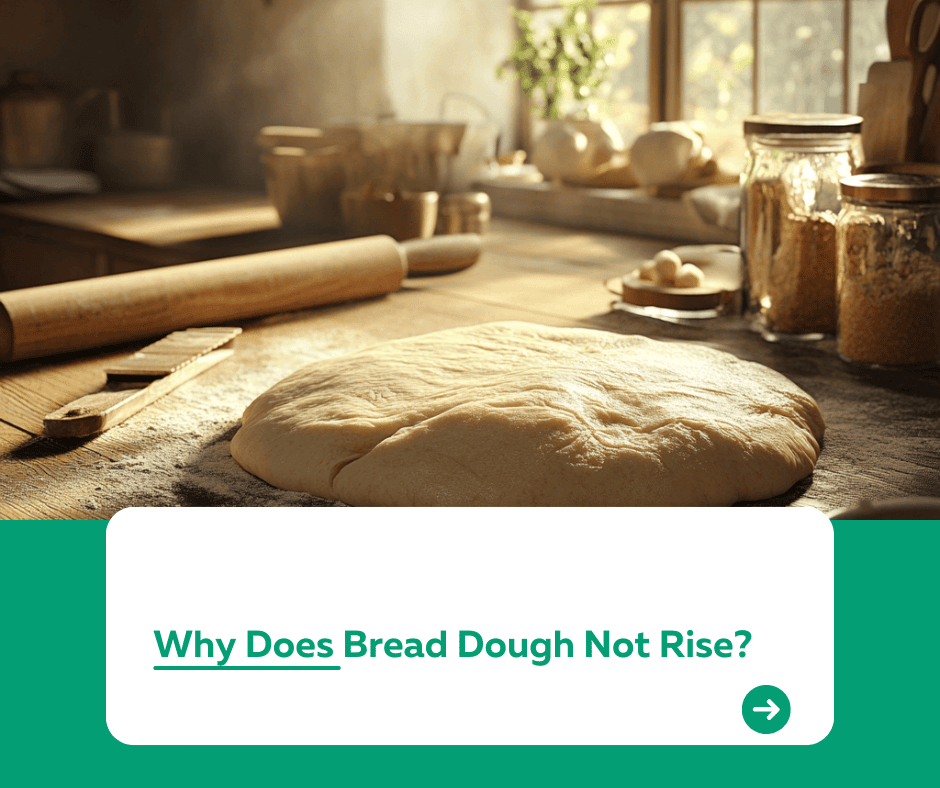
Introduction
Breadmaking can be a rewarding process, but it can also be frustrating when your dough refuses to rise. Why does bread dough not rise, and what can you do to fix it? In this guide, we’ll explore common reasons for this issue and provide solutions to help you achieve the perfect loaf.
1. The Role of Yeast in Rising Dough
Yeast is a living organism that ferments sugars in the dough, producing carbon dioxide, which makes the bread rise. If the yeast isn’t active, your dough won’t rise.
How to Check Yeast Activity:
- Dissolve yeast in warm water (around 110°F or 43°C) with a pinch of sugar.
- If it doesn’t foam or bubble within 10 minutes, the yeast is inactive.
2. Common Reasons Bread Dough Doesn’t Rise
2.1 Expired or Inactive Yeast
- Yeast that’s past its expiration date or stored improperly may no longer be viable.
2.2 Water Temperature Issues
- Water that’s too hot can kill yeast, while cold water may not activate it.
2.3 Insufficient Kneading
- Kneading develops gluten, which traps air bubbles and allows dough to rise. Inadequate kneading results in dense bread.
2.4 Dough Wasn’t Rested Long Enough
- Rising times vary based on temperature and yeast activity. Impatience can lead to under-risen dough.
2.5 Environmental Factors
- Cool room temperatures slow yeast activity. Ideal dough-rising temperatures are between 75°F and 85°F (24°C and 29°C).
2.6 Too Much Salt or Sugar
- Excessive salt can inhibit yeast activity, while too much sugar can dehydrate yeast cells.
2.7 Overworked or Overhydrated Dough
- Overworking dough can destroy gluten structure, while overly wet dough struggles to hold shape and rise.
3. Solutions to Fix Non-Rising Dough
3.1 Reviving Yeast
- Test yeast before starting your recipe. Use fresh, active yeast for best results.
3.2 Adjusting Water Temperature
- Use lukewarm water to activate yeast, ensuring it’s neither too hot nor too cold.
3.3 Create a Warm Rising Environment
- Place dough in a warm, draft-free area. You can use an oven with the light on or a microwave with a cup of hot water inside.
3.4 Allow Proper Resting Time
- Be patient and let the dough rise until it doubles in size, which may take longer in cooler environments.
3.5 Balance Ingredients
- Use precise measurements of salt and sugar to avoid disrupting yeast activity.
3.6 Add More Gluten
- If your dough is too wet or weak, knead in a small amount of bread flour to strengthen the gluten network.
4. Preventing Non-Rising Dough in the Future
- Store Yeast Properly: Keep yeast in an airtight container in the fridge or freezer.
- Use Accurate Measurements: Baking is a science, and small inaccuracies can affect results.
- Follow Recipes Closely: Especially if you’re new to breadmaking.
- Practice Patience: Dough needs time to rise and develop flavor.
Conclusion
Bread dough that doesn’t rise can be caused by inactive yeast, improper conditions, or ingredient imbalances. Understanding the science behind breadmaking and following these tips will help you bake soft, fluffy loaves every time. For more kitchen tips, visit our Kuestion.com.